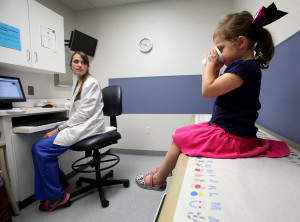Food allergies are a life-changing diagnosis for anyone to get. It requires a complete change in daily activities, learning new skills, and often leads to significant anxiety. For children especially, food allergies increase the risk for developing nutritional deficiencies and could result in failure to thrive. Getting the right diagnosis cannot be underestimated.
Where do you start if you suspect a food allergy? Not just anyone is qualified to help diagnose a food allergy. A board-certified allergist or other physician with experience in diagnosing and managing food allergies is the only one who should be diagnosing a food allergy. Yet, many people self-diagnose, rely on friends or family members, or see practitioners who use unproven techniques and blood tests for diagnosis. You wouldn’t trust your transmission to a plumber or see a podiatrist for a brain tumor – be sure to see the right person to help with this specific issue.
In the US, the most common allergens are milk, egg, peanut, tree nuts, fish, shellfish, wheat and soy, but any food can cause an allergic reaction. Symptoms of an allergic reactions can vary from hives to swelling of the oral cavity, vomiting and diarrhea to a dangerous drop in blood pressure – a reaction can be life-threatening. Diagnosis is a multi-step process.
History: Generally, it starts with collecting an accurate and complete history. Questions to consider include what foods are eaten; how long passes until a reaction occurs; what is the reaction like; and does it happen every time the food is eaten, among others.
Lab Tests: After the history, your doctor may want to conduct a skin prick test, where a small amount of solution containing the protein is applied to the skin, which is then pricked with a probe. A wheal, or a red bump, that shows up on the skin where the prick happened indicates sensitization and possible allergy. A serum IgE blood test may also be conducted to check for antibodies (IgE) that may also point to allergy. Both of these tests have high rates of false positives, but they are very good at ruling out food allergy when tests are negative. (BTW, IgG tests, mediator release testing/LEAP, iridology, and kinesiology are not considered reliable for diagnosing a food allergy.)
Alone, neither history nor these lab tests are enough to diagnose a food allergy. However, together they can help diagnose the allergy.
Oral Food Challenge: The gold standard of food allergy diagnosis is an oral food challenge. A small amount of the suspected allergen is eaten in increasing amounts in a medically supervised environment until a normal amount has been eaten or until reaction occurs. Oral food challenges can trigger a serious reaction (anaphylaxis is the most dangerous reaction that can occur with food allergies), so some physicians are hesitant to perform these if a patient has a history of serious reactions.
Some food allergies are not IgE mediated (they are cell-mediated) and can require additional testing, but diagnosis is often made by carefully ruling out other possibilities. Other adverse reactions to food can also happen, such as intolerances, sensitivities, or the autoimmune disorder celiac disease. These are no less important and should also be diagnosed by a qualified professional and lead you to develop a care team including a registered dietitian.
If food allergies are the ultimate diagnosis, it’ll be really important for you to understand how to manage. One good resource is the NIAID-Sponsored Guide for Management and Diagnosis’ Summary for Patients and Caregivers. Another is the Food Allergy and Anaphylaxis Connection Team, a website devoted to education and advocacy for those with food allergies. Food Allergy Research & Education is another excellent resource for families.
In addition to these DIY resources, I highly recommend seeing a registered dietitian with experience in food allergies. They can help you learn to avoid the allergen…AND deficiencies that can happen as the result of avoidance. I am also available to help, Contact Me.



